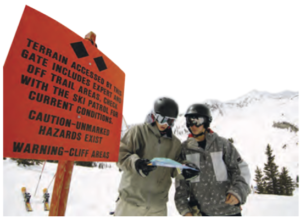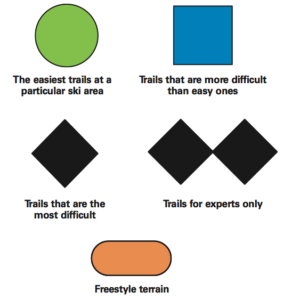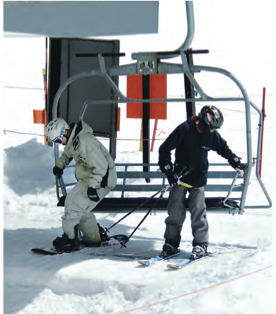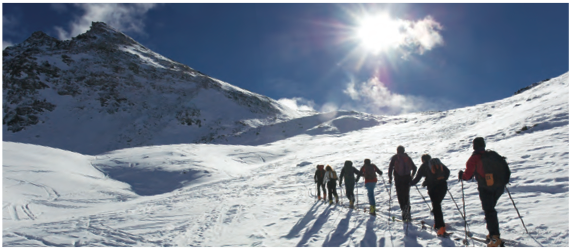Related Advancement
- Second Class requirement 1b
- First Class requirement 1a
- Camping and Snow Sports merit badges
Snow Sports Responsibility Code

- Always stay in control, and be able to stop or avoid other people or objects.
- You must not stop where you obstruct a trail or are not visible from above.
- Whenever starting downhill or merging into a trail, look uphill and yield to others.
- Always use devices to help prevent runaway equipment.
- Observe all posted signs and warnings. Keep off closed trails and out of closed areas.
- Prior to using any lift, you must have the knowledge and ability to load, ride, and unload safely.

This code has been officially endorsed by the National Ski Areas Association, National Ski Patrol, Professional Ski Instructors of America, and the American Association of Snowboard Instructors.
Ski Signs – Like many outdoor activities, snow sports have their own set of signs and symbols. While the exact signs may vary from location to location, most of them will look like these.
Avalanche Dangers –The possibility of avalanches causes serious concern for skiers or riders whose outings take them into snowy, mountainous regions. An avalanche occurs when snow breaks loose on a slope or when a cornice of snow collapses and tumbles down. Often the sliding snow carries debris such as rocks and tree branches with it.
Your greatest protection against avalanches is knowing where, how, and when they are likely to occur and then planning routes that avoid these danger spots. Indicators of danger include the following.
- Steep terrain: Avalanches usually happen on slopes of 40 to 60 degrees.
- Accumulations of new snow: Avalanches generally occur during or after a heavy winter storm. The danger of an avalanche remains high until the new snow settles, consolidates, and becomes stable.
Variations in the quality of snow layers, especially if one or more layers are airy, granular, or in slabs. A weak layer of snowpack can allow layers above to break loose and slide.
Be aware of sounds that suggest cracking or settling of the snowpack.
If, despite your preparations and judgment, you see an avalanche roaring toward you and you cannot get out of its path, jettison (ditch) your pack and your skis or snowboard. When the snow hits, move your arms and legs in a swimming motion to keep yourself upright, and try to keep your head above the surface. As the avalanche settles, push away any accumulation of snow from your face to form an air pocket that will allow you to breathe.
Should others in your party be caught in an avalanche, keep your eye on them as long as you can, and note the exact place you saw them last. Hopefully, they will be wearing avalanche beacons—battery-powered lights that emit a radio signal that can be picked up by the beacons of other group members—that will help you find them quickly. If not, listen for their voices and use your ski poles (grip side down) or a ski to probe the snow.
Search quickly. Your chances of saving a person decrease rapidly as the snow settles. When you find victims, use a sturdy short-handled shovel to free them, and then provide first aid for shock, hypothermia, and any injuries.
If you must cross the path of an avalanche, close up your clothing and put on your hat and gloves. Your chances of survival are much better if you stay warm. Wear a bright-colored avalanche cord. Tie one end to yourself and let the other end trail behind you. If your group has avalanche beacons, make sure you know how to use them and they are working properly.
Ski Lifts
 Downhill skiers and snowboarders need a way to get to the top of the hill in order to come down. While this can be done by Sno-Cat, gondola, bus, and even helicopter, the most common method at most resorts is the ski lift. Rope tows, handle tows, T-bars, platter lifts, and chair lifts are all devices used to get riders to the top of the hill. The Snow Sports merit badge pamphlet is a great resource for learning more about these types of lifts.
Downhill skiers and snowboarders need a way to get to the top of the hill in order to come down. While this can be done by Sno-Cat, gondola, bus, and even helicopter, the most common method at most resorts is the ski lift. Rope tows, handle tows, T-bars, platter lifts, and chair lifts are all devices used to get riders to the top of the hill. The Snow Sports merit badge pamphlet is a great resource for learning more about these types of lifts.
Mountaineering and Backcountry Skiing
Mountaineering skiing combines the skills of downhill skiing with cross-country touring, while adding some of the skills found in mountain climbing. The skis used often employ attachable “skins” that allow them to grip the snow when hiking uphill. Mountaineering skis also may have convertible bindings that allow mobility while hiking but then lock down to allow the skier to ski downhill like an Alpine skier. While this type of skiing has been around for a long time, “split-snowboards” have been introduced recently that allow a rider to climb like a skier but come down as a snowboarder.

Backcountry skiing is considered to be skiing in remote regions outside ski area boundaries. You won’t see a ski patrol, marked ski runs, grooming, snowmaking, or ski lifts. Backcountry skiing can be hazardous due to avalanche, exhaustion, weather, cliffs, rock fall, and tree wells, so advanced skills for handling these hazards are required.
